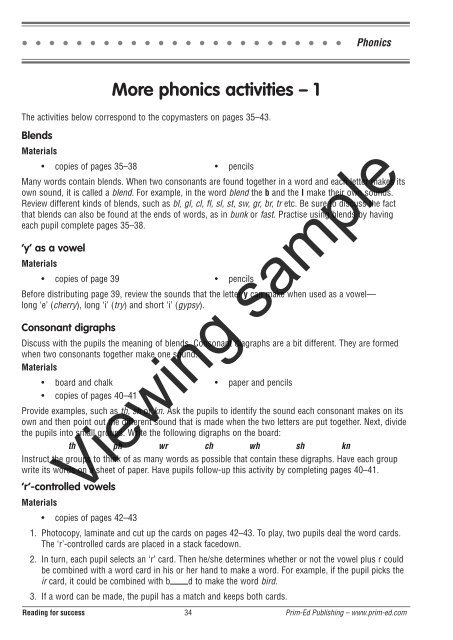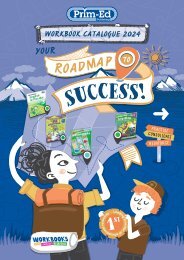PR-6219UK Reading for Success - Book 4
Create successful ePaper yourself
Turn your PDF publications into a flip-book with our unique Google optimized e-Paper software.
Phonics<br />
More phonics activities – 1<br />
The activities below correspond to the copymasters on pages 35–43.<br />
Blends<br />
Materials<br />
• copies of pages 35–38 • pencils<br />
Many words contain blends. When two consonants are found together in a word and each letter makes its<br />
own sound, it is called a blend. For example, in the word blend the b and the l make their own sounds.<br />
Review different kinds of blends, such as bl, gl, cl, fl, sl, st, sw, gr, br, tr etc. Be sure to discuss the fact<br />
that blends can also be found at the ends of words, as in bunk or fast. Practise using blends by having<br />
each pupil complete pages 35–38.<br />
‘y’ as a vowel<br />
Materials<br />
• copies of page 39 • pencils<br />
Be<strong>for</strong>e distributing page 39, review the sounds that the letter y can make when used as a vowel—<br />
long ‘e’ (cherry), long ‘i’ (try) and short ‘i’ (gypsy).<br />
Consonant digraphs<br />
Discuss with the pupils the meaning of blends. Consonant diagraphs are a bit different. They are <strong>for</strong>med<br />
when two consonants together make one sound.<br />
Materials<br />
• board and chalk • paper and pencils<br />
• copies of pages 40–41<br />
Provide examples, such as th, sh or kn. Ask the pupils to identify the sound each consonant makes on its<br />
own and then point out the different sound that is made when the two letters are put together. Next, divide<br />
the pupils into small groups. Write the following digraphs on the board:<br />
th ph wr ch wh sh kn<br />
Instruct the groups to think of as many words as possible that contain these digraphs. Have each group<br />
write its words on a sheet of paper. Have pupils follow-up this activity by completing pages 40–41.<br />
‘r’-controlled vowels<br />
Materials<br />
Viewing sample<br />
• copies of pages 42–43<br />
1. Photocopy, laminate and cut up the cards on pages 42–43. To play, two pupils deal the word cards.<br />
The ‘r’-controlled cards are placed in a stack facedown.<br />
2. In turn, each pupil selects an ‘r’ card. Then he/she determines whether or not the vowel plus r could<br />
be combined with a word card in his or her hand to make a word. For example, if the pupil picks the<br />
ir card, it could be combined with b d to make the word bird.<br />
3. If a word can be made, the pupil has a match and keeps both cards.<br />
<strong>Reading</strong> <strong>for</strong> success 34 Prim-Ed Publishing – www.prim-ed.com


















